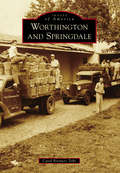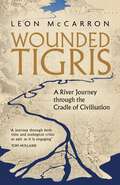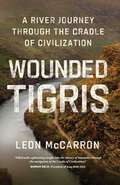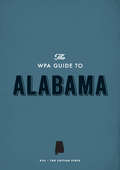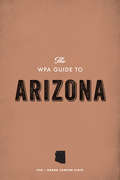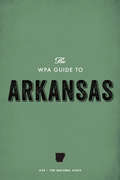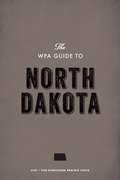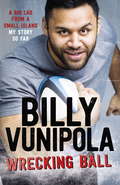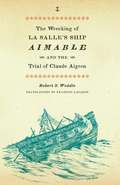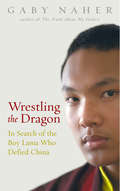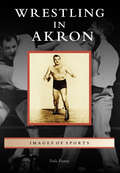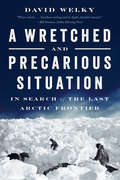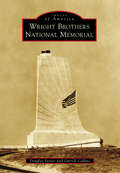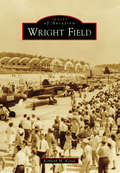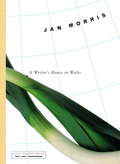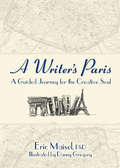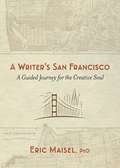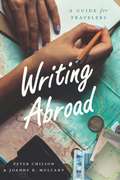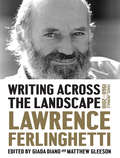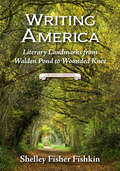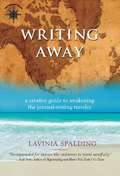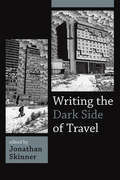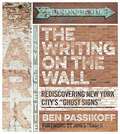- Table View
- List View
Worthington and Springdale (Images of America)
by Carol Brenner TobeThe Jefferson County communities of Worthington and Springdale are located on Brownsboro Road, 12 miles east of Louisville. The area's abundant water sources and fertile soil attracted the earliest settlers in the late 1700s, and farms, mills, and blacksmith shops sprang up along the streams. The Brownsboro Road (originally called Brownsboro Turnpike) served farmers selling their produce, as well as the wealthy "gentleman farmers" who built fine homes in the rural countryside. The fertile soil was particularly suited to growing potatoes, and the Worthington Potato Growers Cooperative handled thousands of barrels daily. The community came together to construct churches and a fine stone school building, establish a cemetery, and organize a fire department. The historic African American community of Taylortown survives in the Taylortown African Methodist Episcopal (AME) Zion Church, established in 1868. Today, suburban sprawl has erased all but a few vestiges of the once-thriving farming communities.
Wounded Tigris: A River Journey through the Cradle of Civilisation
by Leon McCarronThe river Tigris is in danger. It has been the lifeblood of ancient Mesopotamia and modern Iraq, but geopolitics and climate change have left the birthplace of civilisation at risk of becoming uninhabitable. In 2021, adventurer Leon McCarron travelled by boat along the full length of the river, in search of hope.From the source, where Assyrian kings had their images carved into stone, McCarron and his small team journeyed through the Turkish mountains, across north-east Syria and into the heart of Iraq. Passing by historic cities like Diyarbakir, Mosul and Baghdad, McCarron kept the company of fishermen and farmers, but also artists, activists and archaeologists who rely on the flow of the river. Occasionally harassed by militias, often helped by soldiers, McCarron rode his luck in areas still troubled by ISIS and relied on the generosity of a network of strangers to reach the Persian Gulf.Wounded Tigris is the story of what humanity stands to lose with the death of a great river, and what can be done to try to save it.
Wounded Tigris: A River Journey Through the Cradle of Civilization
by Leon McCarronA fascinating journey down the Tigris River—the lifeblood of human civilization—in search of history and hope. Starting at the source of this storied river, where ancient Mesopotamians and Assyrian kings had their images carved into stone, explorer Leon McCarron and his small team will journey through the Turkish mountains, across north-east Syria and into the heart of Iraq. Along the way, they will pass through historic cities like Diyarbakir, Mosul, and Baghdad. We will meet fishermen and farmers, along with artists, activists, and archaeologists, who rely on the flow of the river. Occasionally harassed by militias, often helped by soldiers, McCarron rode his luck in areas still troubled by ISIS and relied on the generosity of a network of strangers as he follows the river to its end in the Persian Gulf. For readers of Simon Winchester, Erika Fatland, and Kevin Fedarko, Wounded Tigris is the story of what humanity stands to lose with the death of a great river, and what can be done to try to save it.
The WPA Guide to Alabama
by Federal Writers' ProjectDuring the 1930s in the United States, the Works Progress Administration developed the Federal Writers’ Project to support writers and artists while making a national effort to document the country’s shared history and culture. The American Guide series consists of individual guides to each of the states. Little-known authors#151;many of whom would later become celebrated literary figures#151;were commissioned to write these important books. John Steinbeck, Saul Bellow, Zora Neale Hurston, and Ralph Ellison are among the more than 6,000 writers, editors, historians, and researchers who documented this celebration of local histories. Photographs, drawings, driving tours, detailed descriptions of towns, and rich cultural details exhibit each state’s unique flavor. The WPA Guide to Alabama takes the reader on a journey of through the heart of Dixie, from the Gulf coast to the rich Black Belt region and the scenic Cumberland Plateau. First published in 1941, the guide goes beyond the popular images of cotton fields and plantation houses of the old south and brings to light the #147;magic” of Birmingham’s burgeoning manufacturing industry, the vibrant university life in Tuscaloosa, and, in Mobile, the cultural diversity of Alabama’s port city. The guide includes striking photos of Southern poverty during the Depression.
The WPA Guide to Arizona
by Federal Writers' ProjectDuring the 1930s in the United States, the Works Progress Administration developed the Federal Writers’ Project to support writers and artists while making a national effort to document the country’s shared history and culture. The American Guide series consists of individual guides to each of the states. Little-known authors-many of whom would later become celebrated literary figures-were commissioned to write these important books. John Steinbeck, Saul Bellow, Zora Neale Hurston, and Ralph Ellison are among the more than 6,000 writers, editors, historians, and researchers who documented this celebration of local histories. Photographs, drawings, driving tours, detailed descriptions of towns, and rich cultural details exhibit each state’s unique flavor. At the time of the publication of the WPA Guide to Arizona in 1940, the Grand Canyon State was the newest addition to the union. The guide presents a state of contrasts, both geographically and culturally. The photographs show many facets of the state-from the mesas and desert lands to the Spanish missions and Native American art.
The WPA Guide to Arkansas
by Federal Writers' ProjectDuring the 1930s in the United States, the Works Progress Administration developed the Federal Writers’ Project to support writers and artists while making a national effort to document the country’s shared history and culture. The American Guide series consists of individual guides to each of the states. Little-known authors#151;many of whom would later become celebrated literary figures#151;were commissioned to write these important books. John Steinbeck, Saul Bellow, Zora Neale Hurston, and Ralph Ellison are among the more than 6,000 writers, editors, historians, and researchers who documented this celebration of local histories. Photographs, drawings, driving tours, detailed descriptions of towns, and rich cultural details exhibit each state’s unique flavor. Published in 1941, the WPA Guide to Arkansas splendidly exhibits the varied environment of the Natural State. From the densely forested land in the Ozark Mountains and Arkansas Timberlands to the Mississippi River and the Arkansas Delta, the guide to the Land of Opportunity provides several photographs of, history on, and driving tours through the state’s grand geography.
The WPA Guide to North Dakota
by Federal Writers' ProjectDuring the 1930s in the United States, the Works Progress Administration developed the Federal Writers' Project to support writers and artists while making a national effort to document the country's shared history and culture. The American Guide series consists of individual guides to each of the states. Little-known authors-many of whom would later become celebrated literary figures-were commissioned to write these important books. John Steinbeck, Saul Bellow, Zora Neale Hurston, and Ralph Ellison are among the more than 6,000 writers, editors, historians, and researchers who documented this celebration of local histories. Photographs, drawings, driving tours, detailed descriptions of towns, and rich cultural details exhibit each state's unique flavor.According to the WPA Guide to North Dakota, there is more to the Northern Prairie State than meets the eye. Primarily an agricultural state, cattle ranching and the pioneer spirit are ever-present in this guide. Also, beautiful photographs of the Great Plains make this a visually pleasing guide the Peace Garden State.
Wrecking Ball: A Big Lad From a Small Island - My Story So Far
by Billy VunipolaVoted Rugby Book of the Year at the 2018 Sports Book Awards.Wrecking Ball is a captivating and humorous memoir by Billy Vunipola, one of the stars of England's recent rugby renaissance, and will be enjoyed by those who have read the recent autobiographies by Jonny Wilkinson, Brian O'Driscoll, Dan Carter and Paul O'Connell.Standing at 6 feet 2 inches and weighing almost 20 stone, Billy is a rampaging and unmissable presence on the rugby pitch, for both club and country. Wrecking Ball is his captivating story so far, chronicling his remarkable personal odyssey of 10,000 miles, from the tiny Tongan village of Longo Longo to the imposing vastness of Twickenham.Join Billy on his journey from the year-round sunshine of Tonga to the bitter cold of a British winter, from his favourite Pontypool kebab shop to finding himself eating broccoli for breakfast, and from carefree childhood games in the middle of the Pacific to the serious business of playing professional rugby in Europe. Wrecking Ball is a wonderfully eccentric and witty book, written with bags of charm. It captures Billy's colourful family and upbringing, and creates a rounded and fascinating portrait of a young man finding his feet as a modern English rugby player.
Wrecking Ball: A Big Lad From a Small Island - My Story So Far
by Billy VunipolaWrecking Ball is a captivating and humorous memoir by Billy Vunipola, one of the stars of England's recent rugby renaissance, and will be enjoyed by those who have read the recent autobiographies by Jonny Wilkinson, Brian O'Driscoll, Dan Carter and Paul O'Connell.Standing at 6 feet 2 inches and weighing almost 20 stone, Billy is a rampaging and unmissable presence on the rugby pitch, for both club and country. Wrecking Ball is his captivating story so far, chronicling his remarkable personal odyssey of 10,000 miles, from the tiny Tongan village of Longo Longo to the imposing vastness of Twickenham.Join Billy on his journey from the year-round sunshine of Tonga to the bitter cold of a British winter, from his favourite Pontypool kebab shop to finding himself eating broccoli for breakfast, and from carefree childhood games in the middle of the Pacific to the serious business of playing professional rugby in Europe. Wrecking Ball is a wonderfully eccentric and witty book, written with bags of charm. It captures Billy's colourful family and upbringing, and creates a rounded and fascinating portrait of a young man finding his feet as a modern English rugby player.(P)2017 Headline Publishing Group Ltd.
The Wrecking of La Salle's Ship Aimable and the Trial of Claude Aigron
by Robert S. WeddleWhen Robert Cavelier, sieur de La Salle, landed on the Texas coast in 1685, bent on founding a French colony, his enterprise was doomed to failure. Not only was he hundreds of miles from his intended landfall--the mouth of the Mississippi--but his supply ship, Aimable, was wrecked at the mouth of Matagorda Bay, leaving the colonists with scant provisions and little protection against local Indian tribes. In anger and disgust, he struck out at the ship's captain, Claude Aigron, accusing him of wrecking the vessel purposely and maliciously. Captain Aigron and his crew escaped the doomed colony by returning to France on the warship that had escorted the expedition on its ocean crossing. Soon after reaching France, Aigron found himself defendant in a civil suit filed by two of his officers seeking recompense for lost salary and personal effects, and then imprisoned on order of King Louis XIV while La Salle's more serious accusations were being investigated. In this book, Robert Weddle meticulously recounts, through court documents, the known history of Aigron and the Aimable, and finds that despite La Salle's fervent accusations, the facts of the case offer no clear indictment. The court documents, deftly translated by François Lagarde, reveal Captain Aigron's successful defense and illuminate the circumstances of the wreck with Aigron's testimony. Much is also revealed about the French legal system and how the sea laws of the period were applied through the French government's L'Ordonnance de la Marine.
Wrestling The Dragon: In search of the Tibetan lama who defied China
by G Naher Gaby NaherHe's master of the PlayStation, he listens to rap music, he writes poetry and, in his eighteen-year-old hands, may hold the future of the Tibetan people. He is Ogyen Trinley Dorje, a Tibetan lama and the seventeenth incarnation of the Karmapa (third in line to the Dalai Lama). When he was fourteen, Ugyen fled Tibet and began his journey into exile - and the Chinese lost the boy they hoped would one day replace the Dalai Lama in the hearts of six million Tibetans. Today, he lives under house arrest, ostensibly being 'protected' by the Indian Government - which is more likely protecting its relationship with China. So begins the true story of the 17th Karmapa of Tibet, a story which has all the elements of a cracking tale: magical portents at his birth, a village childhood on the Roof of the World, attempted indoctrination by the Chinese-his short life provides a fascinating insight into the Contemporary Tibetan struggle, while his future as a religious leader of global significance is already being forecast. To write this story, Gaby Naher intends to travel throughout the region and interview key players of the Tibetan Government in Exile, as well as religious figures in the area.
Wrestling in Akron (Images of Sports)
by Dale PierceFrom the time it was founded in 1825, Akron was a town on the move. Once known as the "Rubber Capitol of the World," it brought droves of new workers to downtown and the suburban areas. With expansion came a need for entertainment, and wrestling was there for the multitudes. From the contrast of high school amateurs on mats to snarling villains and heroes in the professional ring, the sport thrived. There were the early days of traveling carnivals, with circuit-riding wrestlers who would take on all comers from the audience, to secretive fights set by shifty promoters in railroad yards with onlookers placing bets. There were the glory days of the Akron Armory--offering the crowd a chance to see such luminaries as the cigar-chewing Killer Tim Brooks, the smiling Johnny Powers, or the devious Don Kent--and beyond after the famed arena closed.
A Wretched and Precarious Situation: In Search of the Last Arctic Frontier
by David WelkyA Kirkus Reviews Best Nonfiction Book of 2016 A remarkable true story of adventure, betrayal, and survival set in one of the world’s most inhospitable places. In 1906, from atop a snow-swept hill in the ice fields northwest of Greenland, hundreds of miles from another human being, Commander Robert E. Peary spotted a line of mysterious peaks looming in the distance. He called this unexplored realm “Crocker Land.” Scientists and explorers agreed that the world-famous explorer had discovered a new continent rising from the frozen Arctic Ocean. Several years later, two of Peary’s disciples, George Borup and Donald MacMillan, assembled a team of amateur adventurers to investigate Crocker Land. Before them lay a chance at the kind of lasting fame enjoyed by Magellan, Columbus, and Captain Cook. While filling in the last blank space on the globe, they might find new species of plants or animals, or even men; in the era of Jules Verne and H. G. Wells, anything seemed possible. Renowned scientific institutions, and even former president Theodore Roosevelt, rushed to endorse the expedition. What followed was a sequence of events that none of the explorers could have imagined. Trapped in a true-life adventure story, the men endured howling blizzards, unearthly cold, food shortages, isolation, a fatal boating accident, a drunken sea captain, disease, dissension, and a horrific crime. But the team pushed on through every obstacle, driven forward by the mystery of Crocker Land and faint hopes that they someday would make it home. Populated with a cast of memorable characters, and based on years of research in previously untapped sources, A Wretched and Precarious Situation is a harrowing Arctic narrative unlike any other.
Wright Brothers National Memorial (Images of America)
by Douglas Stover Darrell CollinsWilbur and Orville Wright made the world’s first successful controlled, heavier-than-air powered flight on December 17, 1903, after four years of glider experiments and scientific study. At what is now the Wright Brothers National Memorial, the brothers discovered and developed the fundamental principles of mechanical flight, setting in motion a series of events that allowed the first generation of flight to travel from Kitty Hawk to the moon in the lifetime of a human being. Located in Kill Devil Hills, North Carolina, and administered by the National Park Service, the Wright Brothers National Memorial features a full-scale reproduction of the 1903 flying machine, an engine block from the original 1903 flyer, and a precise reproduction of the wind tunnel that the Wrights used to conduct their early experiments. Today, the park’s mission is to commemorate the Wrights’ success and to interpret the continuing worldwide significance of their dream, vision, and achievement.
Wright Field: The Wright Brothers To Mccook Field (Images of Aviation)
by Kenneth M. KeiselFrom its founding in 1927 until the establishment of Wright-Patterson Air Force Base in 1948, Wright Field played a vital role keeping the Army Air Force positioned as the world's leader in aircraft design and development. The Second World War catapulted it into the forefront of America's war effort, as virtually every new aircraft produced for the Army Air Force was developed and tested in Dayton. Wright Field's testing program also had the fascinating task of studying captured enemy aircraft, including some powered by jet engines, which engineers at the installation were also developing. Images of Aviation: Wright Field features scores of amazing photographs that tell the story of the airfield from its founding in 1927 through World War II, the Cold War, and beyond. Readers will also see the impact the base has played in the local community by providing thousands of jobs, as well as some of the greatest air shows ever held in the United States. Finally, a collection of crash photographs reveals the often tragic consequences that inevitably come with the testing of advanced experimental aircraft.
A Writer's House in Wales
by Jan MorrisTrefan Morys, Morris's home between the sea and mountains of the remote northwest corner of Wales, is the 18th-century stable block of her former family house nearby. Surrounding it are the fields and outbuildings, the mud, sheep, and cattle of a working Welsh farm. She regards this modest building not only as a reflection of herself and her life, but also as epitomizing the small and complex country of Wales, which has defied the world for centuries to preserve its own identity. Morris brilliantly meditates on the beams and stone walls of the house, its jumbled contents, its sounds and smells, its memories and inhabitants, and finally discovers the profoundest meanings of Welshness.
A Writer's House in Wales
by Jan MorrisThrough an exploration of her country home in Wales, acclaimed travel writer Jan Morris discovers the heart of her fascinating country and what it means to be Welsh. Trefan Morys, Morris's home between the sea and mountains of the remote northwest corner of Wales, is the 18th-century stable block of her former family house nearby. Surrounding it are the fields and outbuildings, the mud, sheep, and cattle of a working Welsh farm. She regards this modest building not only as a reflection of herself and her life, but also as epitomizing the small and complex country of Wales, which has defied the world for centuries to preserve its own identity. Morris brilliantly meditates on the beams and stone walls of the house, its jumbled contents, its sounds and smells, its memories and inhabitants, and finally discovers the profoundest meanings of Welshness.
A Writer's Paris: A Guided Journey for the Creative Soul
by Eric MaiselEnrich your life and write with more intensity than ever on a spirit-renewing adventure in the City of Light. Experience Paris not as a tourist but as a creator, where you dedicate yourself to the bohemian life in picturesque parks, cafés, and bookstores. In this guided tour of a beloved destination that has sparked the imagination of countless writers and artists, leading creativity coach Eric Maisel offers insights on how to use the city to spur commitment to your craft. Beyond the metaphor of Paris as a place of creativity, Maisel provides practical tools for you to use upon committing to this journey: tips for writing at the Place des Vosges while soaking in the surrounding architecture and vibrant energy; advice on the best time to visit the Musée d'Orsay for maximum inspiration; and ideas for engaging all the senses during strolls through churches and subways of this dazzling location. In brief essays that are whimsically illustrated, Maisel helps you put your dreams into action, encouraging you to move beyond the idea of living and writing in Paris to the reality of doing it, for three weeks or three years or anytime in between.
A Writer's San Francisco: A Guided Journey for the Creative Soul (Creativity And Journaling Ser.)
by Eric Maisel"Maisel has a wonderful voice and A Writer's San Francisco reads like a gritty, fluent love letter. He moves seamlessly between thoughtful descriptions of modern San Francisco and the San Francisco of the '60s and '70s in narratives that bring the city alive on the page. His affection and respect for the city are inspiring to all writers and artists, but also to anyone who has ever spent time in San Francisco and fallen in love with her." — Chris DeLorenzo, Laguna Writers Workshop San Francisco holds a special place in the history of American literature and in the hearts of creative people everywhere. In thirty-one essays, Eric Maisel takes you on an enchanted journey through one of the world's greatest cities. Walk San Francisco's twisting streets, climb its famous hills, explore bohemian landmarks like City Lights Bookstore, and check out lesser-known neighborhoods. Along the way, Maisel conjures the city's past and present writers, including Twain, Ferlinghetti, and Kerouac, and tells personal stories from his own years as a Bay Area writer, teacher, and creativity coach. Whether you're a San Francisco native, a visitor, an armchair traveler, or an artistic soul seeking inspiration, you'll find lots to inspire you in these pages.
Writing Abroad: A Guide for Travelers
by Peter Chilson Joanne B. Mulcahy“Tell me all about your trip!” It’s a request that follows travelers as they head out into the world, and one of the first things they hear when they return. When we leave our homes to explore the wider world, we feel compelled to capture the experiences and bring the story home. But for those who don’t think of themselves as writers, putting experiences into words can be more stressful than inspirational. Writing Abroad is meant for travelers of all backgrounds and writing levels: a student embarking on overseas study; a retiree realizing a dream of seeing China; a Peace Corps worker in Kenya. All can benefit from documenting their adventures, whether on paper or online. Through practical advice and adaptable exercises, this guide will help travelers hone their observational skills, conduct research and interviews, choose an appropriate literary form, and incorporate photos and videos into their writing. Writing about travel is more than just safeguarding memories—it can transform experiences and tease out new realizations. With Writing Abroad, travelers will be able to deepen their understanding of other cultures and write about that new awareness in clear and vivid prose.
Writing Across the Landscape: Travel Journals 1950–2013
by Matthew Gleeson Lawrence Ferlinghetti Giada DianoThis long-awaited volume provides a panoramic portrait of art and life across the twentieth century, from Mexico to Morocco, Paris to Rome, and beyond. Over the course of an adventured-filled life, now in its tenth decade, Lawrence Ferlinghetti has been many things: a poet, painter, pacifist, publisher, courageous defender of free speech, and owner of San Francisco’s legendary City Lights bookstore. Now the man whose A Coney Island of the Mind became a generational classic reveals yet another facet of his manifold talents, presenting here his travel journals, spanning over sixty years. Selected from a vast trove of mostly unpublished, handwritten notebooks, and edited by Giada Diano and Matthew Gleeson, Writing Across the Landscape becomes a transformative work of social, cultural, and literary history. Beginning with Ferlinghetti's account of serving as a commanding officer on a Navy sub-chaser during D-Day, Writing Across the Landscape dramatically traverses the latter half of the twentieth century. For those only familiar with his poetry, these pages present a Lawrence Ferlinghetti never before encountered, an elegant prose stylist and tireless political activist who was warning against the pernicious sins of our ever-expansive corporate culture long before such thoughts ever seeped into mainstream consciousness. Yet first and foremost we see an inquisitive wanderer whose firsthand accounts of people and places are filled with pungent descriptions that animate the landscapes and cultures he encounters. Evoking each journey with a mixture of travelogue and poetry as well as his own hand-drawn sketches, Ferlinghetti adopts the role of an American bard, providing panoramic views of the Cuban Revolution in Havana, 1960, and a trip through Haiti, where voodoo and Catholicism clash in cathedrals "filled with ulcerous children's feet running from Baron Hunger." Reminding us that poverty is not only to be found abroad, Ferlinghetti narrates a Steinbeck-like trip through California's Salton Sea, a sad yet exquisitely melodic odyssey from motel to motel, experiencing the life "between cocktails, between filling stations, between buses, trains, towns, restaurants, movies, highways leading over horizons to another Rest Stop…Sad hope of all their journeys to Nowhere and back in dark Eternity." Particularly memorable is his journey across the Trans-Siberian Railway in 1957, which turns into a Kafkaesque nightmare in which he, lacking a proper visa, is removed from a Japan-bound freighter and forced back across the Russian steppe to Moscow, encountering a countryside more Tolstoy than Khrushchev, while nearly dying in the process. Readers are also treated to glimpses of Ezra Pound, "looking like an old Chinese sage," whom Ferlinghetti espies in Italy, as well as fellow Beat legends Allen Ginsberg and a dyspeptic William S. Burroughs, immured with his cats in a grotto-like apartment in London. Embedded with facsimile manuscript pages and an array of poems, many never before published, Writing Across the Landscape revives an era when political activism coursed through the land and refashions Lawrence Ferlinghetti, not only as a seminal poet but as an historic and singular American voice.
Writing America
by Shelley Fisher FishkinAmerican novelist E.L. Doctorow once observed that literature "endows places with meaning." Yet, as this wide-ranging new book vividly illustrates, understanding the places that shaped American writers' lives and their art can provide deep insight into what makes their literature truly meaningful. Published on the eve of the 50th anniversary of the Historic Preservation Act, Writing America is a unique, passionate, and eclectic series of meditations on literature and history, covering over 150 important National Register historic sites, all pivotal to the stories that make up America, from chapels to battlefields; from plantations to immigration stations; and from theaters to internment camps. The book considers not only the traditional sites for literary tourism, such as Mark Twain's sumptuous Connecticut home and the peaceful woods surrounding Walden Pond, but also locations that highlight the diversity of American literature, from the New York tenements that spawned Abraham Cahan's fiction to the Texas pump house that irrigated the fields in which the farm workers central to Gloria Anzaldúa's poetry picked produce. Rather than just providing a cursory overview of these authors' achievements, acclaimed literary scholar and cultural historian Shelley Fisher Fishkin offers a deep and personal reflection on how key sites bore witness to the struggles of American writers and inspired their dreams. She probes the global impact of American writers' innovative art and also examines the distinctive contributions to American culture by American writers who wrote in languages other than English, including Yiddish, Chinese, and Spanish. Only a scholar with as wide-ranging interests as Shelley Fisher Fishkin would dare to bring together in one book writers as diverse as Gloria Anzaldúa, Nicholas Black Elk, David Bradley, Abraham Cahan, S. Alice Callahan, Raymond Chandler, Frank Chin, Elizabeth Cook-Lynn, Countee Cullen, Frederick Douglass, Paul Laurence Dunbar, Jessie Fauset, William Faulkner, F. Scott Fitzgerald, Allen Ginsberg, Jovita González, Rolando Hinojosa, Langston Hughes, Zora Neale Hurston, Lawson Fusao Inada, James Weldon Johnson, Erica Jong, Maxine Hong Kingston, Irena Klepfisz, Nella Larsen, Emma Lazarus, Sinclair Lewis, Genny Lim, Claude McKay, Herman Melville, N. Scott Momaday, William Northup, John Okada, Miné Okubo, Simon Ortiz, Américo Paredes, John P. Parker, Ann Petry, Tomás Rivera, Wendy Rose, Morris Rosenfeld, John Steinbeck, Harriet Beecher Stowe, Henry David Thoreau, Mark Twain, Yoshiko Uchida, Tino Villanueva, Nathanael West, Walt Whitman, Richard Wright, Hisaye Yamamoto, Anzia Yezierska, and Zitkala-Ša. Leading readers on an enticing journey across the borders of physical places and imaginative terrains, the book includes over 60 images, and extended excerpts from a variety of literary works. Each chapter ends with resources for further exploration. Writing America reveals the alchemy though which American writers have transformed the world around them into art, changing their world and ours in the process. Table of ContentsList of Illustrations Acknowledgments Introduction: The Literary Landscape1 Celebrating the Many in One Walt Whitman Birthplace, Huntington, Long Island, New York2 Living in Harmony with Nature Walden Pond, Concord, Massachusetts3 Freedom's Port The New Bedford Whaling National Historical Park, New Bedford, Massachusetts4 The House that Uncle Tom's Cabin Built Harriet Beecher Stowe House, Hartford, Connecticut5 The Irony of American History The Mark Twain Boyhood Home, Hannibal, Missouri, and the Mark Twain House, Hartford, Connecticut6 Native American Voices Remember Wounded Knee, Pine Ridge Indian Reservation, South Dakota7 "I Know Why the Caged Bird Sings" The Paul Laurence Dunbar House, Dayton, Ohio8 Leaving the Old World for the New The Tenement Museum, New York City9 The Revolt from the Village The Original Main Street, Sauk Centre, Minnesota10 Asian American Writers and Creativ...
Writing Away
by Lavinia SpaldingTwo major trends have recently swept the travel world: the first, an overwhelming desire (thanks to Elizabeth Gilbert's bestseller, Eat, Pray, Love) to write one's own memoir; the second, an explosion of social media, blogs, twitter and texts, which allow travelers to document and share their experiences instantaneously. Thus, the act of chronicling one's journey has never been more popular, nor the urge stronger.Writing Away: A Creative Guide to Awakening the Journal-Writing Traveler, will inspire budding memoirists and jetsetting scribes alike. But Writing Away doesn't stop there-author Lavinia Spalding spins the romantic tradition of keeping a travelogue into a modern, witty adventure in awareness, introducing the traditional handwritten journal as a profoundly valuable tool for self-discovery, artistic expression, and spiritual growth.Writing Away teaches you to embrace mishaps in order to enrich your travel experience, recognize in advance what you want to remember, tap into all your senses, and connect with the physical world in an increasingly technological age. It helps you overcome writer's block and procrastination; tackle the discipline, routine, structure, and momentum that are crucial to the creative process; and it demonstrates how traveling-while keeping a journal along the way-is the world's most valuable writing exercise.
Writing The Dark Side Of Travel
by Jonathan SkinnerThe travel experience filled with personal trauma; the pilgrimage through a war-torn place; the journey with those suffering: these represent the darker sides of travel. What is their allure and how are they represented? This volume takes an ethnographic and interdisciplinary approach to explore the writings and texts of dark journeys and travels. In traveling over the dead, amongst the dying, and alongside the suffering, the authors give us a tour of humanity's violence and misery. And yet, from this dark side, there comes great beauty and poignancy in the characterization of plight; creativity in the comic, graphic, and graffiti sketches and comments on life; and the sense of profound and spiritual journeys being undertaken, recorded, and memorialized.
The Writing on the Wall: Rediscovering New York City's "Ghost Signs"
by James Trager Ben PassikoffThe New York Times' pick in "A Holiday Gift Guide for Hardcover Fans"A Publishers Weekly pick in "Holiday Gift Guide 2017: Illustrated Gift Books"A Photographic and Historical Record of the City’s Vanishing Advertisements As the great city of New York moves, changes, and evolves every day, the few remnants of its past go unnoticed. New York City’s "ghost signs” -advertisements painted across the facades of buildings that date back to the 19th century-are often invisible to the busy New Yorker, but defiantly conspicuous if only we turn our eyes and look upwards. These faded representations of the city’s rich economic and social history are slowly disappearing before our eyes, but not before they were captured by this photographer’s lens.At the tender age of sixteen, Ben Passikoff roamed around Manhattan with his camera to document these fascinating signs-hand-painted messages written all over the city. This photographic collection features signs painted in the 1800s as well as in the 21st century; signs that advertise funeral homes, meat, and underwear; signs stretched across iconic buildings; and even signs that are no longer legible. Using his photographs as a looking-glass into the past, Passikoff provides insightful commentary on the economic, social, and historical significance of commerce in New York City, and its vanishing ghost signs, now preserved in this photographic record.
